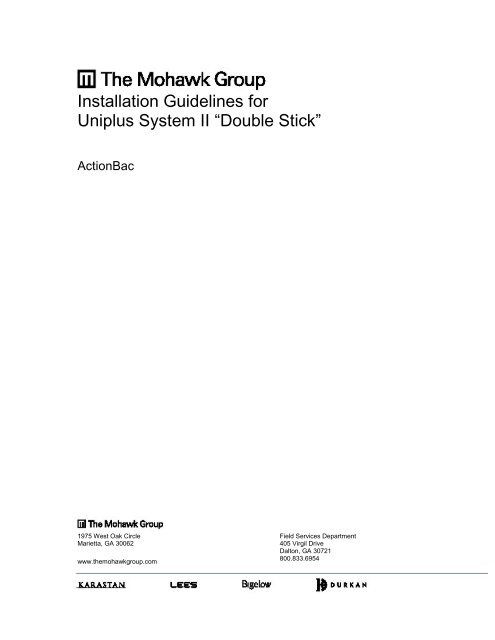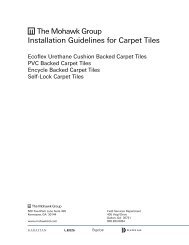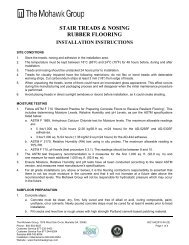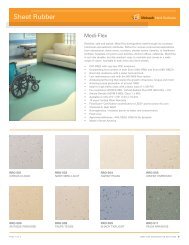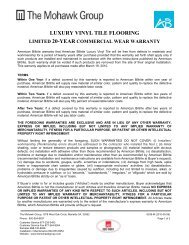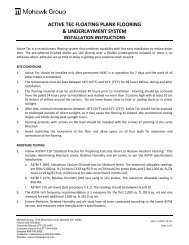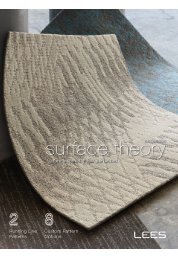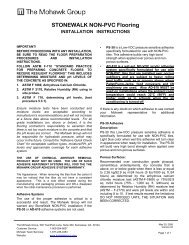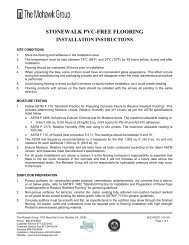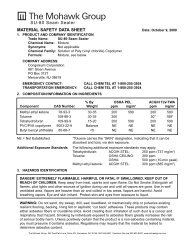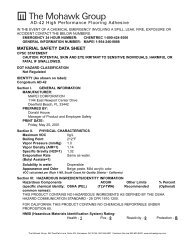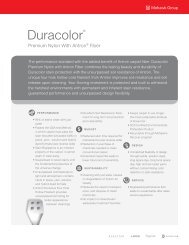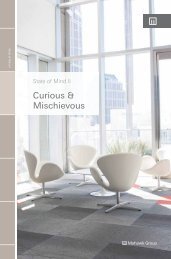Installation Guidelines for Uniplus System II ... - Mohawk Group
Installation Guidelines for Uniplus System II ... - Mohawk Group
Installation Guidelines for Uniplus System II ... - Mohawk Group
Create successful ePaper yourself
Turn your PDF publications into a flip-book with our unique Google optimized e-Paper software.
<strong>Installation</strong> <strong>Guidelines</strong> <strong>for</strong><br />
<strong>Uniplus</strong> <strong>System</strong> <strong>II</strong> “Double Stick”<br />
ActionBac<br />
1975 West Oak Circle<br />
Marietta, GA 30062<br />
www.themohawkgroup.com<br />
Field Services Department<br />
405 Virgil Drive<br />
Dalton, GA 30721<br />
800.833.6954
2<br />
Be<strong>for</strong>e <strong>Installation</strong><br />
The floor and room temperature should remain a minimum of 65º F and a maximum of 95° F <strong>for</strong> 72 hours<br />
be<strong>for</strong>e and 48 hours after installation. Take the reading from a thermometer placed on the floor. Repeat in<br />
scattered areas.<br />
Store the carpet and adhesive at 65° F to 95° F on site 24 to 48 hours be<strong>for</strong>e installation. If possible,<br />
unroll as much of the carpet as possible 24 hours be<strong>for</strong>e the installation.<br />
Remove <strong>for</strong>eign materials, such as paint, old glue, etc. by sanding.<br />
Remove and sand any protrusions in the floor. Fill cracks more than 1/16-inch wide with a Portland or<br />
cement-based flashing compound.<br />
1. Conduct a moisture test. Moisture in the subfloor will interfere with the curing and<br />
per<strong>for</strong>mance of the adhesive. Moisture should not exceed a reading of 5.0 pounds per 1,000 square<br />
feet per 24 hours as determined by a calcium chloride test per ASTM F1869, or 80% RH per ASTM<br />
F2170. If the results are more than 5lbs or higher than 80%, stop and contact Field Services @<br />
800.833.6954<br />
2. The alkalinity or pH in the concrete slab should be between 5 and 9. Should the pH be outside this<br />
range, stop and contact Field Services @ 800.833.6954.<br />
NOTE: Do not sand any products containing asbestos.<br />
NOTE: When removing carpet from a surface containing asbestos, be certain to consult applicable local,<br />
state, and federal guidelines <strong>for</strong> the handling of asbestos containing materials.<br />
TIP: Meet with the general contractor several days be<strong>for</strong>e installation. Discuss areas of responsibility so<br />
acceptance of the floor is a smooth transition.<br />
Recommended Adhesives<br />
TMG Enpress PSA Adhesive is recommended to adhere the pad to the subfloor. The<br />
approximate spread rate is 40 yards per gallon.<br />
Lees WetSet Adhesive or NuBroadlok Adhesive is recommended to adhere the carpet to the pad. The approximate spread rate<br />
is 6-7 yards per gallon.<br />
Recommended Equipment<br />
• TMG Enpress PSA Adhesive<br />
• 1/8” x 1/16” x 1/8” U-Notch Trowel<br />
• Loop Pile Cutter<br />
• Natural Fiber Push Brooms<br />
• Wagner Power Steamer or Jiffy Steamer<br />
• Lees WetSet Adhesive or TMG NuBroadlok<br />
• Paint Roller<br />
• Razor Blade Knife<br />
• Steel Nails<br />
• NuBroadlok Seam Sealer<br />
Patterned Carpets<br />
The installer must measure and define the exact pattern match be<strong>for</strong>e beginning the installation.<br />
The exact pattern match may vary slightly from the match stated in the product specifications.<br />
Measure the length of at least 30 repeats. If the pattern is less than 4” in length, increase the number<br />
of repeats until the measured length is at least 120” (10’). If the pattern repeat is larger than 12”, the<br />
measurement does not need to exceed 360” (30’). Measure the same number of repeats on every roll,<br />
making the measurements down the middle of the roll. All rolls are within a tolerance of +/- 1.0% of the<br />
average of pattern repeats <strong>for</strong> all the rolls. Calculate each manufacturing order individually.<br />
NOTE: For more in<strong>for</strong>mation on matching patterned carpets, please call Field Service at<br />
1-800-833-6954 <strong>for</strong> our technical bulletin, “Installing Patterned Carpets.”<br />
Installing the Cushion<br />
1. After you complete all floor preparation, plan the layout of the cushion. Install the cushion in the<br />
longest lengths possible with consideration <strong>for</strong> traffic patterns and seam placement.<br />
2. Cut and fit the pad.<br />
3. Fold back the cushion and begin applying the Pressure Sensitive Adhesive to the floor. Use a 3/8”nap<br />
paint roller to apply the adhesive.
3<br />
4. Install the cushion into the adhesive after the adhesive dries (turns clear).<br />
5. Place the cushion onto the adhesive and adjust so there are no gaps at the seams and full contact is<br />
made with adhesive.<br />
6. Smooth air bubbles with a 2-foot length of carpet core or the bottom of a toolbox shelf.<br />
NOTE: The goal is to coat the floor with a continuous thin film of adhesive. A thick film will make it<br />
harder to remove the cushion from the floor at the end of the carpet service life.<br />
Installing the Carpet<br />
IMPORTANT! Spread out all carpet 24 hours prior to the actual installation. The temperature in the room<br />
should be between 65° and 95° F. Also, plan the loc ation <strong>for</strong> any dye lot changes to eliminate shading<br />
problems.<br />
NOTE: Be sure the carpet lays flat and the pile runs in the same direction. Directional arrows are<br />
provided on the back of the carpet.<br />
1. To begin the installation, roughly locate the carpet so seams will be either at right angles to the<br />
cushion seams or offset at least six inches to either side.<br />
2. Trim all seam edges with the appropriate seam cutting tools be<strong>for</strong>e spreading the adhesive.<br />
3. From a starting point near the center of the room, snap a white chalk line on the floor, measuring from<br />
the perpendicular walls. This marks the location of your first seam.<br />
4. Dry lay the carpet by overlapping the edges 1½” over the chalk line. Allow an extra 1½” at the walls<br />
<strong>for</strong> trimming.<br />
5. Check the carpet <strong>for</strong> the direction of pile lay, being careful to keep the carpet going in the same dire tion.<br />
6. To facilitate installation <strong>for</strong> patterned carpets, use the measurements obtained previously and lay out<br />
the rolls in measurement sequence. Start the installation in the middle of the space using the rolls that<br />
have the largest pattern repeat. This allows you to stretch rolls with smaller repeat measurements to<br />
match up to the rolls with larger repeat measurements.<br />
7. To start the seam, select one edge <strong>for</strong> cutting and fold the other side out of the way. Trim off the<br />
factory edges when seaming.<br />
8. To make a clean, straight cut <strong>for</strong> length seams, use the following procedure <strong>for</strong> straight row<br />
constructions:<br />
• Use a screwdriver or the tip of cushion back cutter to separate the yarn and visibly open a row<br />
approximately 1” from the edge.<br />
• Cut along the opening with a cushion back cutter, working down the entire length of the first piece<br />
of carpet.<br />
• To obtain a tight seam, cut close to the main body by trimming with the blade close to the seam<br />
edge. Be sure to hold the cutter straight up and down.<br />
• On non pattern goods only, use the trace cut method to cut the second carpet edge to ensure a well fitted<br />
seam.<br />
9. To make a clean, straight cut <strong>for</strong> length seams, use the following procedure <strong>for</strong> staggered or shifted<br />
row constructions:<br />
• Working from the back of the carpet, snap a chalk line down the length of the carpet about 1” from<br />
the edge.<br />
• Use a straight edge and knife to carefully cut along the line. Cut through both the backing and the<br />
primary back. Avoid cutting excessive face yarn.<br />
• Then trace cut the seam edge of the second carpet(non pattern goods only), butting from the face, or use<br />
the straight edge method and cut from the back side.<br />
10. Position the first trimmed edge along the chalk line.<br />
11. After positioning the second edge against the first, check the alignment. Both edges should lay flat<br />
and fit together to <strong>for</strong>m a tight seam without compression.
4<br />
12. If the edges don’t fit together properly or tuft rows are slightly bowed, use the trace cut method and<br />
re-cut to make the seam <strong>for</strong> non pattern goods only.<br />
13. Once the seam edges fit correctly, weight or stay-nail the center line of both carpets length-wise to prevent<br />
the carpet from shifting. Carefully fold back both breadths of carpet, being careful not to shift the carpet.<br />
14. Check the carpet at the seam <strong>for</strong> height variation and correct to a level appearance if necessary.<br />
NOTE: The trace cut method is done by siding the second seam edge about 1 ½-inch under the first edge.<br />
Using the first edge as a guide, trim the second edge, holding the cutter straight up and down. Be<strong>for</strong>e<br />
removing the cut piece, be sure the carpet is cut completely through. This method is <strong>for</strong> non pattern goods only.<br />
NOTE: When installing patterned carpets, a perfect match at the seams may not always be possible However,<br />
an installation professional should obtain a reasonable pattern match. In the labor quotation, make<br />
considerations <strong>for</strong> installation requirements. Please request a copy of our technical bulletin “Installing<br />
Patterned Carpets” from Field Services (1-800-833-6954) if you have questions about installing<br />
patterned carpets.<br />
Applying the Adhesive<br />
NOTE: TMG recommends that you begin the installation with a NEW trowel and re-notch or replace the<br />
trowel every 300 yards to maintain proper adhesive coverage.<br />
1. Use only a 1/8” x 1/8” x 1/16” V-notch trowel. Maintain proper notch size throughout the<br />
installation. Spread the adhesive uni<strong>for</strong>mly over the cushion.<br />
2. Allow the adhesive 20 minutes of open time.<br />
3. After spreading the adhesive, lay the folded edge of the first cut over the adhesive. To do this, the<br />
installers should position themselves at intervals along the entire length of the fold and grasp the<br />
folded edge. The installers must lift the folded edge and walk ahead, <strong>for</strong>ming a wedge.<br />
4. Use a stiff bristle push broom to smooth the fabric toward the seam. You can use cardboard roll cores<br />
cut into 2-foot lengths <strong>for</strong> pressing the carpet into place. Nylon short bristle brooms are not recommended;<br />
they tend to catch in the carpet pile.<br />
5. Apply a 1/8” bead of seam sealer to the cut edge at the proper height to lock in the tufts and seal the<br />
edge of the first cut.<br />
6. Grasp the folded edge of the second breadth of carpet and place it over the adhesive. This flap should<br />
be walked in evenly rather than using the wedge method. The installers should walk in all but one foot<br />
of the second breadth, then fold that same amount back again.<br />
7. Step onto the first cut and face the second cut. Holding thumbs up, grasp the 1-foot fold and place it<br />
into the adhesive approximately 1/2-inch from the edge of the first cut.<br />
8. Slide the edge until it slightly abuts the edge of the first roll. Do not let the seam peak. The seam<br />
adhesive on the edge of the first length will transfer to the edge of the second length to seal the seam<br />
and prevent fraying.<br />
9. In case of slight peaks or gaps, use a knee kicker to move the carpet slightly to obtain a closed and<br />
even seam.<br />
10. Brush or roll any looseness and trapped air bubbles away from the seam with a light roller or the back<br />
of a floor broom. You must complete this procedure be<strong>for</strong>e the adhesive sets up.<br />
11. Turn the unglued portion of the first length of carpet back toward the seam and spread the adhesive<br />
<strong>for</strong> a 6-foot width along the entire length.<br />
12. Lay the carpet into the adhesive. Brush or roll any looseness and trapped air toward the wall and away<br />
from the seam.<br />
13. Cut the next and continuing lengths of carpet and position each. Repeat the above procedures to<br />
complete the installation.<br />
14. While the adhesive is still tacky, press the carpet into the adhesive along the wall. The carpet may be<br />
trimmed using a Roberts 10-905 wall trimmer. Trim and fit the end walls and around jogs, pillars, etc.<br />
as each length is installed.
5<br />
Installing UniPlus <strong>II</strong> on Stairs<br />
1. Use the multi-purpose adhesive to adhere the pad to the steps and the carpet to the pad.<br />
2. Use a 1/8 x 1/16 x 1/8 V-notch trowel <strong>for</strong> the adhesion of the pad to the stairs and the carpet to the pad.<br />
3. On heavy traffic areas, TMG recommends using a tackless strip in a traditional strip and pad manner<br />
along with the glue method. This allows the installer to stretch the stairs tight.<br />
Carpet Protection<br />
Protect the carpet edges with a vinyl or metal strip fastened securely to the floor.<br />
Protect the installation from heavy traffic <strong>for</strong> 24 hours.<br />
Plastic film or sheeting should not be used as carpet protection because it retards adhesive curing.<br />
For adhesive removal, cover the adhesive spot with Durasafe 2007 Paint, Oil, Grease & Adhesive<br />
Remover and allow five minutes of dwelling time. Use a scraping tool in a circular motion to collect the<br />
loosened adhesive. Vacuum the area thoroughly after drying to remove crystals and encapsulated soil.<br />
CAUTION!: Do not use chlorinated cleaning solutions, quaternary solutions, petroleum distillates,<br />
or citrus-based cleaning solutions to remove adhesive from the face fiber of TMG carpet.<br />
Please Note: The use of TMG branded adhesives are required to ensure optimum results and are<br />
the only approved adhesives that Lees’ Carpet will warrant. Failure to use TMG branded<br />
adhesives can result in warranties being null and void.<br />
This in<strong>for</strong>mation, offered as a customer service, is based on The <strong>Mohawk</strong> <strong>Group</strong>’s engineering tests and field<br />
experience. It is intended <strong>for</strong> installers with professional experience, to be used at their discretion and risk. TMG<br />
Carpet does not guarantee results and assumes no liability in connection with these installation instructions.


